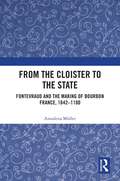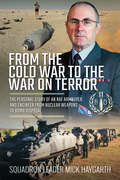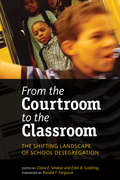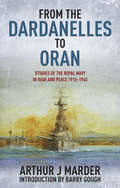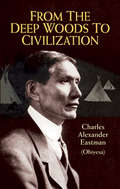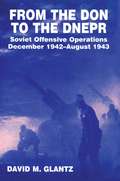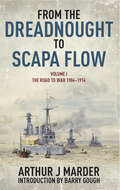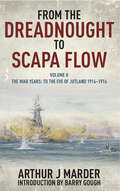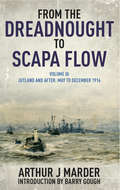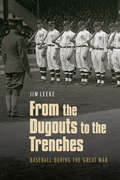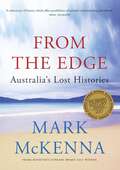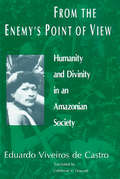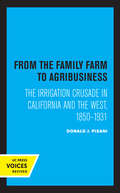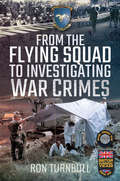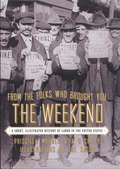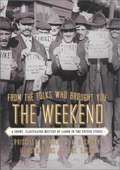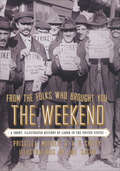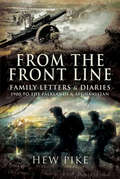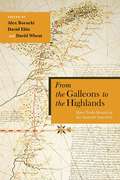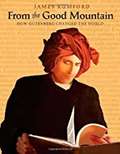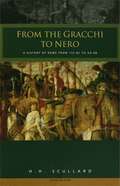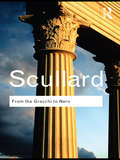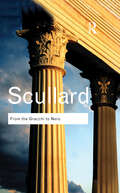- Table View
- List View
From the Cloister to the State: Fontevraud and the Making of Bourbon France, 1642-1100
by Annalena MüllerFrom the Cloister to the State examines the French order of Fontevraud, one of the largest monastic networks under female leadership in medieval and early modern Europe. Founded in 1100 and comprised of both monks and nuns, the order had grown to consist of at least seventy-eight priories by the late Middle Ages. Endowed with vast territorial possessions throughout western France, Fontevraud became one of the most powerful religious institutions in the country. However, unaware of its institutional might and economic wealth, scholars have tended to focus on Fontevraud’s seemingly unusual gender hierarchy, while bypassing inquiries on practices of abbatial authority in Fontevraud and beyond. This book reveals medieval Fontevraud as an aristocratic cloister where noble women governed. It also discusses the value of Fontevraud’s extensive network for the geopolitical ambitions of the dukes of Brittany, the counts of Bourbon-Vendôme, and, during the Wars of Religion, the kings of France. In addition to Fontevraud’s political role during the Wars of Religion, the book also examines the order’s reforms implemented by Marie de Bretagne and her successors Renée and Louise de Bourbon-Vendôme. These Bourbon abbesses centralized the order’s administration, cut the ties between priories and local aristocratic families, and successfully established the Bourbon-Vendômes as the only patrons of the vast and wealthy network. This book is essential reading for scholars and students of medieval and early modern history, as well as those interested in political history and the history of religion.
From the Cold War to the War on Terror: The Personal Story of an RAF Armourer and Engineer from Nuclear Weapons to Bomb Disposal
by Mick HaygarthA bomb-disposal expert shares stories from conflict zones ranging from the Falklands to Kosovo to Iraq.Michael Haygarth left home just before his seventeenth birthday to join the Royal Air Force as a Weapons Technician. At the time, everything seemed routine—but his thirty-eight-year career turned out to be anything but. Training with nations all over the world; fast roping out of helicopters with US Army Rangers; being driven around Basra in a beaten-up taxi wearing civilian clothes with a 9mm pistol in his waistband; convoying at speed around Baghdad with the US Army looking for unexploded bombs—all were way beyond the usual experiences of an RAF Engineer.In his early career, he was a member of a Buccaneer Nuclear Weapon Loading Team stationed in RAF Germany at the height of the Cold War. Frequently woken by sirens in the early morning hours, he’d rush to work wondering if it was yet another practice or the start of nuclear Armageddon. After further tours, and having passed his Bomb Disposal courses, he was then sent to the Falkland Islands. He also served in Kosovo as part of a huge multinational force tasked with clearing thousands of bombs and cluster munitions, as well as working with the International Crimes Tribunal to clear numerous mass graves. He was responsible for all UK Bomb Disposal operations in and around Pristina.Next came an operational tour to Iraq, where he made further use of his bomb disposal expertise. After promotion to Squadron Leader, he worked in the Ministry of Defense and then took charge of the RAF’s only Bomb Disposal Squadron as it withdrew from Iraq, and was instrumental in refocusing the squadron to carry out operations in Afghanistan alongside the Army. His final role, in what was a truly exceptional career, was in charge of the RAF’s only expeditionary Engineering Squadron as it worked through the busiest period in its history during the UK forces’ withdrawal from Afghanistan and the escalation of events in support of operations in the Baltic states and Syria. In this book, he tells his remarkable story.
From the Courtroom to the Classroom: The Shifting Landscape of School Desegregation
by Claire E. Smrekar Ronald F. Ferguson Ellen B. GoldringFrom the Courtroom to the Classroom examines recent developments pertaining to school desegregation in the United States. As the editors note, it comes at a time marked by a "general downplaying of race and ethnicity as criteria for the allocation of public resources, as well as a weakening of the political forces that support busing to achieve racial integration." The book fills a growing need for a full-scale assessment of this recent history and its effect on schools, children, and communities.
From the Courtroom to the Classroom: The Shifting Landscape of School Desegregation
by Claire Smrekar and Ellen GoldringFrom the Courtroom to the Classroom examines recent developments pertaining to school desegregation in the United States. As the editors note, it comes at a time marked by a &“general downplaying of race and ethnicity as criteria for the allocation of public resources, as well as a weakening of the political forces that support busing to achieve racial integration.&” The book fills a growing need for a full-scale assessment of this recent history and its effect on schools, children, and communities.
From the Dardanelles to Oran: Studies of the Royal Navy in War and Peace, 1915–1914
by Arthur J. MarderThis collection of thought-provoking essays by arguably the 20th century's greatest naval historian was first published in 1974, but their continuing relevance fully justifies this reprint. It opens with a stimulating reappraisal of the naval attack on the Dardanelles, the success of which would have made the disastrous Gallipoli land campaign that followed completely unnecessary. Marder identifies a number of relatively minor issues that made a failure of what was in reality a great strategic opportunity to shorten the war. Other chapters cover what the Royal Navy did and did not learn from the Great War, and Churchill's controversial time at the Admiralty before he became Prime minister in 1940, while Marder's analysis of the inter-war Ethiopian Crisis asking whether military aggression can be countered by sanctions has powerful echoes of current political concerns. The final essay looks at one of the most contentious episodes of the Second World War, the British pre-emptive strike on the fleet of their one-time allies at Oran after the French surrender in 1940.Because Marder's view of history emphasises the human dimension over abstract forces, his work is always approachable in style and of as much interest to the layman as the professional historian. This book is no exception.
From the Deep Woods to Civilization
by Charles Alexander EastmanIn the first of his memoirs, the popular Indian Boyhood, Charles Alexander Eastman recounted his traditional upbringing among the Santee Sioux. From the Deep Woods to Civilization resumes his story, recounting his abrupt departure from tribal life at age 15 to pursue his education among whites — a path that led him to certification as a medical doctor, the publication of many successful books, and a lifetime of tireless efforts to benefit his native culture. Through his social work and his writings, Eastman became one of the best-known Indians of the early twentieth century and an important force in interpreting and relating the spiritual depth and greatness of the Native American traditions.Eastman became a physician in hopes of serving the Native American community; he received a Bachelor of Science degree from Dartmouth in 1887 and a medical degree from Boston University in 1890. He began college just a few months after the Battle of Little Bighorn, and his first job as a physician at Pine Ridge Reservation coincided with the Ghost Dance uprisings that culminated in the U. S. Army's attack at Wounded Knee. The only doctor available to assist the massacre's victims, Eastman writes movingly of the event's appalling inhumanity and injustice. Afterward, he lobbied Capitol Hill on behalf of the Sioux and devoted the rest of his life, both in and out of government service, to helping Indians adapt to the white world while retaining the best of their own culture. His autobiography resonates with the impassioned thoughts and experiences of a profound contributor to the richness of American culture.
From the Deep Woods to Civilization: Chapters in the Autobiography of an Indian
by Charles A. EastmanThis book chronicles the unique experience of a Native American, Charles A. Eastman, who experienced his original Sioux culture in Southern Canada for the first fifteen years of his life, after which he was taken by his father to the USA.
From the Don to the Dnepr: Soviet Offensive Operations, December 1942 - August 1943 (Soviet (Russian) Military Experience #Vol. 1)
by David M. GlantzThis book provides an in-depth study of the Soviet Army during the offensive operations that started with Battle of Stalingrad in December 1942 and went until Spring 1943. The lessons learned by the Soviet Army from these experiences helped design the military steamroller that decimated the German panzer divisions at Kursk in the Summer of 1943.
From the Dreadnought to Scapa Flow, Volume I: The Road to War 1904–1914 (From The Dreadnought To Scapa Flow Ser.)
by Arthur Marder“A masterpiece . . . an indispensable source on the Royal Navy’s development in the decade before the First World War.” —War in HistoryThe five volumes that constitute Arthur Marder’s From the Dreadnought to Scapa Flow represented arguably the finest contribution to the literature of naval history since Alfred Mahan. A. J. P. Taylor wrote that “his naval history has a unique fascination. To unrivalled mastery of sources he adds a gift of simple narrative . . . He is beyond praise, as he is beyond cavil.”The five volumes were subtitled The Royal Navy in the Fisher Era, 1904–1919 and they are still, despite recent major contributions from Robert Massie and Andrew Gordan, regarded by many as the definitive history of naval events leading up to and including the Great War. This first volume covers many facets of the history of the Royal Navy during the pre-war decade, including the economic and political background such as the 1906 Liberal Government hostility towards naval spending. Inevitably, however, attention moves to the German naval challenge, the arms race and the subsequent Anglo-German rivalry, and, finally, the British plans for the blockade of the German High Seas Fleet. A new introduction by Barry Gough, the distinguished Canadian maritime and naval historian, assesses the importance of Marder’s work and anchors it firmly amongst the great naval narrative histories of this era.This ebook edition will bring a truly great work to a new generation of historians and general readers.“[An] extensive and masterly classic work of the Royal Navy in the Great War. A prodigious work of scholarship.” —Scuttlebutt (Friends of the RN Museum)
From the Dreadnought to Scapa Flow, Volume II: To The Eve of Jutland 1914–1916 (From The Dreadnought To Scapa Flow Ser.)
by Arthur MarderThe five volumes that constitute Arthur Marder's From the Dreadnought to Scapa Flow represented arguably the finest contribution to the literature of naval history since Alfred Mahan. A J P Taylor wrote that 'his naval history has a unique fascination. To
From the Dreadnought to Scapa Flow, Volume III: Jutland and After May to December 1916 (From The Dreadnought To Scapa Flow Ser.)
by Arthur J. MarderVolume III in this definitive WWI naval history presents an in-depth analysis of the Battle of Jutland, with a new introduction by historian Barry Gough. Arthur Marder's five-volume history From the Dreadnought to Scapa Flow is one of the finest contributions to naval history, chronicling the dramatic conflicts of the First World War with an &“unrivalled mastery of sources&” and &“a gift of simple narrative&” (A.J.P. Taylor). The third volume presents an in-depth analysis of the clash between the German High Seas fleet and the British Grand Fleet and Battlecruiser Fleet at Jutland, as well as its immediate aftermath. Marder's intricate charting of this great battle is still recognized as the authoritative statement on these events. A new introduction by Barry Gough, the distinguished Canadian maritime and naval historian, assesses the importance of Marder's work and anchors it firmly amongst the great naval narrative histories of this era.
From the Dugouts to the Trenches: Baseball during the Great War
by Jim LeekeBaseball, like the rest of the country, changed dramatically when the United States entered World War I, and Jim Leeke brings these changes to life in From the Dugouts to the Trenches. He deftly describes how the war obliterated big league clubs and largely dismantled the Minor Leagues, as many prominent players joined the military and went overseas. By the war’s end more than 1,250 ballplayers, team owners, and sportswriters would serve, demonstrating that while the war was “over there,” it had a considerable impact on the national pastime. Leeke tells the stories of those who served, as well as organized baseball’s response, including its generosity and patriotism. He weaves into his narrative the story of African American players who were barred from the Major Leagues but who nevertheless swapped their jerseys for fatigues, as well as the stories of those who were killed in action—and by diseases or accidents—and what their deaths meant to teammates, fans, and the sport in general.From the Dugouts to the Trenches illuminates this influential and fascinating period in baseball history, as nineteen months of upheaval and turmoil changed the sport—and the world—forever.
From the Edge: Australia's Lost Histories
by Mark McKennaIn March 1797, five British sailors and 12 Bengali seamen struggled ashore after their longboat broke apart in a storm. Their fellow-survivors from the wreck of the Sydney Cove were stranded more than 500 kilometres southeast in Bass Strait. To rescue their mates and to save themselves the 19 men must walk 700 kilometres north to Sydney.That remarkable walk is a story of endurance but also of unexpected Aboriginal help.From the Edge: Australia's Lost Histories recounts four such extraordinary and largely forgotten stories: the walk of shipwreck survivors; the founding of a 'new Singapore' in western Arnhem Land in the 1840s; Australia's largest industrial development project nestled amongst outstanding Indigenous rock art in the Pilbara; and the ever-changing story of James Cook's time in Cooktown in 1770.This new telling of the central drama of Australian history ;the encounter between Aboriginal and non-Aboriginal Australians, may hold the key to understanding this land and its people.
From the Enemy's Point of View: Humanity and Divinity in an Amazonian Society
by Eduardo Viveiros de CastroThe Araweté are one of the few Amazonian peoples who have maintained their cultural integrity in the face of the destructive forces of European imperialism. In this landmark study, anthropologist Eduardo Viveiros de Castro explains this phenomenon in terms of Araweté social cosmology and ritual order. His analysis of the social and religious life of the Araweté—a Tupi-Guarani people of Eastern Amazonia—focuses on their concepts of personhood, death, and divinity. Building upon ethnographic description and interpretation, Viveiros de Castro addresses the central aspect of the Arawete's concept of divinity—consumption—showing how its cannibalistic expression differs radically from traditional representations of other Amazonian societies. He situates the Araweté in contemporary anthropology as a people whose vision of the world is complex, tragic, and dynamic, and whose society commands our attention for its extraordinary openness to exteriority and transformation. For the Araweté the person is always in transition, an outlook expressed in the mythology of their gods, whose cannibalistic ways they imitate. From the Enemy's Point of View argues that current concepts of society as a discrete, bounded entity which maintains a difference between "interior" and "exterior" are wholly inappropriate in this and in many other Amazonian societies.
From the Family Farm to Agribusiness: The Irrigation Crusade in California and the West, 1850–1931
by Donald J. PisaniThis title is part of UC Press's Voices Revived program, which commemorates University of California Press’s mission to seek out and cultivate the brightest minds and give them voice, reach, and impact. Drawing on a backlist dating to 1893, Voices Revived makes high-quality, peer-reviewed scholarship accessible once again using print-on-demand technology. This title was originally published in 1984.
From the Flying Squad to Investigating War Crimes
by Ron Turnbull“Looks at more recent genocide through the eyes of a British detective who spent time investigating Bosnian war crimes . . . fascinating insight.” —FiretrenchFor over ten years he was first detective on the scene when a murder was committed in south London. In the confusion and horror of the crime scene he identified the forensic clues that would later be needed to convict the killer in the calm and measured atmosphere of the Old Bailey; calling out the necessary experts from pathologists to ballistics specialists; protecting the scene against contamination. One slip and a case would crumble; one moment of inspiration and the Yard would have its man. He was the natural choice when the UN were looking for an experienced detective to create a trail of evidence linking the mass graves of Bosnia to the people who ordered the worst war crimes seen in Europe since the Second World War. From the Flying Squad to Investigating War Crimes tells of the rise of forensic evidence against the true story backdrop of a detective who has spent a career at the front line in the war against murder—the ultimate crime. It traces the development of forensic science and techniques from the days of the fingerprint to the battery of tests now available to homicide investigators. It is told in the no nonsense style of a pioneer cop who has seen the worst that human beings can do to each other.“The extraordinary autobiography of an extraordinary man who gathered evidence against the most heinous criminals.” —Books Monthly
From the Folks Who Brought You the Weekend
by Joe Sacco Priscilla Murolo A. B. ChittyHailed in a starred Publishers Weekly review as a work of "impressive even-handedness and analytic acuity . . . that gracefully handles a broad range of subject matter," From the Folks Who Brought You the Weekend is the first comprehensive look at American history through the prism of working people. From indentured servants and slaves in the seventeenth-century Chesapeake to high-tech workers in contemporary Silicon Valley, the book "[puts] a human face on the people, places, events, and social conditions that have shaped the evolution of organized labor" (Library Journal).From the Folks Who Brought You the Weekend also "thoroughly includes the contributions of women, Native Americans, African Americans, immigrants, and minorities, and considers events often ignored in other histories," writes Booklist, which adds that "thirty pages of stirring drawings by 'comic journalist' Joe Sacco add an unusual dimension to the book."
From the Folks Who Brought You the Weekend: A Short, Illustrated History of Labor in the United States
by Joe Sacco Priscilla Murolo A. B. ChittyHailed in a starred "Publishers Weekly" review as a work of "impressive even-handedness and analytic acuity . . . that gracefully handles a broad range of subject matter, " This is the first comprehensive look at American history through the prism of working people.
From the Folks Who Brought You the Weekend: An Illustrated History of Labor in the United States
by Priscilla Murolo A.B. ChittyNewly updated: &“An enjoyable introduction to American working-class history.&” —The American Prospect Praised for its &“impressive even-handedness&”, From the Folks Who Brought You the Weekend has set the standard for viewing American history through the prism of working people (Publishers Weekly, starred review). From indentured servants and slaves in seventeenth-century Chesapeake to high-tech workers in contemporary Silicon Valley, the book &“[puts] a human face on the people, places, events, and social conditions that have shaped the evolution of organized labor&”, enlivened by illustrations from the celebrated comics journalist Joe Sacco (Library Journal). Now, the authors have added a wealth of fresh analysis of labor&’s role in American life, with new material on sex workers, disability issues, labor&’s relation to the global justice movement and the immigrants&’ rights movement, the 2005 split in the AFL-CIO and the movement civil wars that followed, and the crucial emergence of worker centers and their relationships to unions. With two entirely new chapters—one on global developments such as offshoring and a second on the 2016 election and unions&’ relationships to Trump—this is an &“extraordinarily fine addition to U.S. history [that] could become an evergreen . . . comparable to Howard Zinn&’s award-winning A People&’s History of the United States&” (Publishers Weekly). &“A marvelously informed, carefully crafted, far-ranging history of working people.&” —Noam Chomsky
From the Frontline: Family Letters and Diaries: 1900 to the Falklands and Afghanistan
by Hew PikeFrom the Frontline is an extraordinary record of a familys military service over the last 100 years. Thanks to careful editing, each individual tells his story through letters and diaries which capture the military scene and reflect family ties that bind them all closely. The eight family members served in South Africa, West Africa, Korea, Aden, the Falklands and Afghanistan as well as both World Wars. One lost his life and others were wounded. Two became generals, many were decorated. Their records may span a century when warfare changed greatly. Yet the tone of the letters remains surprisingly constant reflecting confidence in their fellows, a pride in service to Crown and Country, love of family and understatement of the dangers. Being thinking men, their views on the conduct of operations is sometimes critical as are their opinions of their leaders. This collection is highly unusual and totally enthralling.
From the Galleons to the Highlands: Slave Trade Routes in the Spanish Americas (Diálogos Series)
by Alex Borucki, David Eltis and David WheatThe essays in this book demonstrate the importance of transatlantic and intra-American slave trafficking in the development of colonial Spanish America, highlighting the Spanish colonies&’ previously underestimated significance within the broader history of the slave trade. Spanish America received African captives not only directly via the transatlantic slave trade but also from slave markets in the Portuguese, English, Dutch, French, and Danish Americas, ultimately absorbing more enslaved Africans than any other imperial jurisdiction in the Americas except Brazil. The contributors focus on the histories of slave trafficking to, within, and across highly diverse regions of Spanish America throughout the entire colonial period, with themes ranging from the earliest known transatlantic slaving voyages during the sixteenth century to the evolution of antislavery efforts within the Spanish empire. Students and scholars will find the comprehensive study and analysis in From the Galleons to the Highlands invaluable in examining the study of the slave trade to colonial Spanish America.Understanding Latin America demands dialogue, deep exploration, and frank discussion of key topics. Founded by Lyman L. Johnson in 1992 and edited since 2013 by Kris Lane, the Diálogos Series focuses on innovative scholarship in Latin American history and related fields. The series, the most successful of its type, includes specialist works accessible to a wide readership and a variety of thematic titles, all ideally suited for classroom adoption by university and college teachers.
From the Good Mountain: How Gutenberg Changed The World
by James RumfordWhat was made of rags and bones, soot and seeds? What took a mountain to make? <p><p> For the answer, travel back to the fifteenth century―to a time when books were made by hand and a man named Johannes Gutenberg invented a way to print books with movable type. <p> Written as a series of riddles and illustrated in the style of medieval manuscripts by an award-winning author and artist, From the Good Mountain will intrigue readers of all ages. On every page there is something surprising to learn about how the very thing you are holding in your hands came to be.
From the Gracchi to Nero: A History of Rome 133 BC to AD 68
by H. H. ScullardScullard's clear and comprehensive narrative covers the period from 133 BC to 69 AD, exploring the decline and fall of the Republic, and the establishment of the Pax Romana under the early Principate. More than forty years after its first publication this masterful survey remains the standard textbook on the central period of Roman history.
From the Gracchi to Nero: A History of Rome 133 BC to AD 68
by H. H. ScullardFrom the Gracchi to Nero is an outstanding history of the Roman world from 133 BC to 68 AD. Fifty years since publication it is widely hailed as the classic survey of the period, going through many revised and updated editions until H.H. Scullard’s death. It explores the decline and fall of the Roman Republic and the establishment of the Pax Romana under the early Principate. In superbly clear style, Scullard brings vividly to life the Gracchi’s attempts at reform, the rise and fall of Marius and Sulla, Pompey and Caesar, society and culture in the late Roman Republic, the Augustan Principate, Tiberius and Gaius, Claudius and Nero, and economic and social life in the early Empire.
From the Gracchi to Nero: A History of Rome 133 BC to AD 68 (Routledge Classics)
by H.H. ScullardFrom the Gracchi to Nero is an outstanding history of the Roman world from 133 BC to 68 AD. Fifty years since publication it is widely hailed as the classic survey of the period, going through many revised and updated editions until H.H. Scullard’s death. It explores the decline and fall of the Roman Republic and the establishment of the Pax Romana under the early Principate. In superbly clear style, Scullard brings vividly to life the Gracchi’s attempts at reform, the rise and fall of Marius and Sulla, Pompey and Caesar, society and culture in the late Roman Republic, the Augustan Principate, Tiberius and Gaius, Claudius and Nero, and economic and social life in the early Empire.
